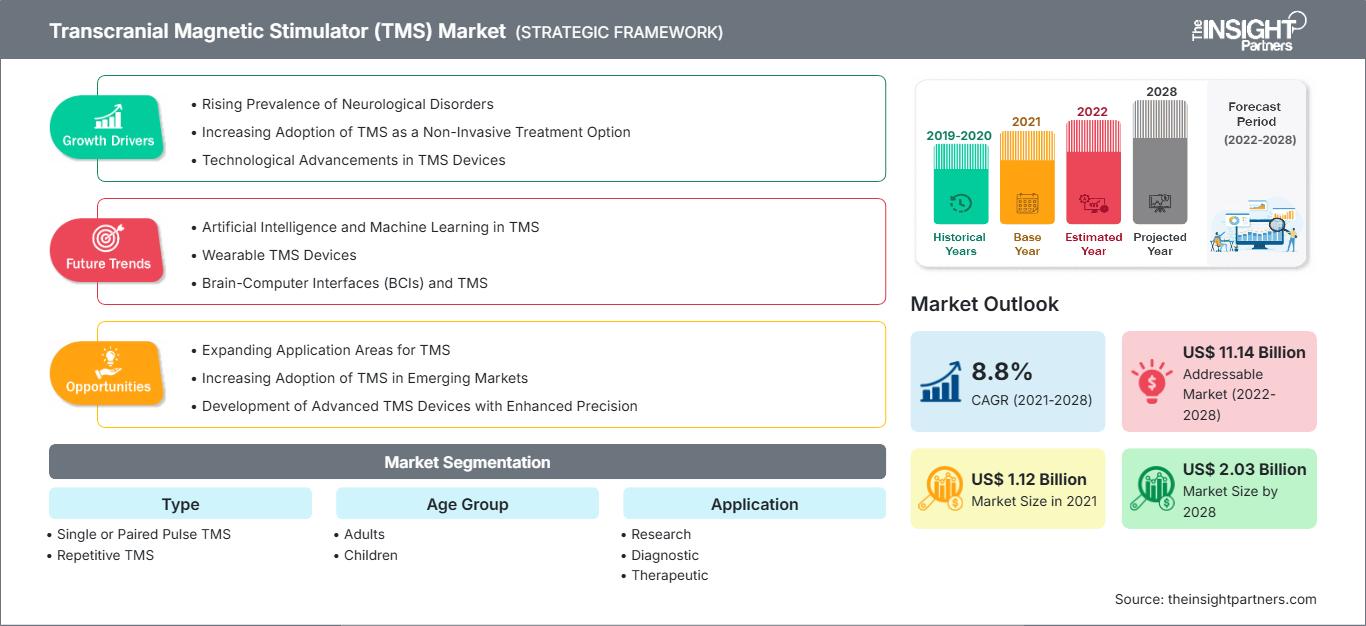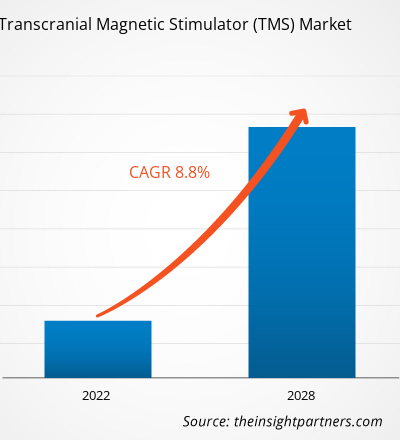[Rapporto di ricerca]Si prevede che il mercato degli stimolatori magnetici transcranici (TMS) raggiungerà i 2.029,71 milioni di dollari entro il 2028, rispetto ai 1.122,22 milioni di dollari del 2021; si prevede un CAGR dell'8,8% dal 2021 al 2028.
I disturbi neurologici colpiscono il cervello e i nervi del corpo umano e causano, tra gli altri, epilessia e convulsioni, morbo di Parkinson, demenza, autismo, morbo di Alzheimer, tumori cerebrali e paralisi cerebrale. La prevalenza dei disturbi neurologici è in aumento in tutto il mondo. Secondo il Global Burden of Disease Study (GBD) 2017, il morbo di Alzheimer e altre demenze [2,55 milioni di anni di vita aggiustati per disabilità (DALY)], l'ictus [circa 3,58 milioni di DALY] e l'emicrania (circa 2,40 milioni di DALY) sono state le tre malattie neurologiche più gravose negli Stati Uniti in termini di numero totale di anni di vita aggiustati per disabilità.
Inoltre, l'Alzheimer's Association stima che oltre 6 milioni di americani soffrano di Alzheimer e si prevede che tale numero raggiungerà quasi 13 milioni entro il 2050. La stimolazione magnetica transcranica (TMS) è ampiamente utilizzata per la diagnosi e il trattamento dei disturbi neurologici. Ad esempio, secondo BrainsWay Ltd., nell'aprile 2021, 100.000 pazienti in tutto il mondo sono stati trattati con la sua TMS profonda. Pertanto, la crescente prevalenza di disturbi neurologici guida la crescita del mercato globale degli stimolatori magnetici transcranici (TMS). Inoltre, la depressione è uno dei disturbi mentali più comuni in tutto il mondo. Secondo i dati pubblicati dall'OMS a gennaio 2020, oltre 264 milioni di persone di tutte le età soffrono di depressione in tutto il mondo.
Personalizza questo rapporto in base alle tue esigenze
Potrai personalizzare gratuitamente qualsiasi rapporto, comprese parti di questo rapporto, o analisi a livello di paese, pacchetto dati Excel, oltre a usufruire di grandi offerte e sconti per start-up e università
Mercato degli stimolatori magnetici transcranici (TMS): Approfondimenti strategici

- Ottieni le principali tendenze chiave del mercato di questo rapporto.Questo campione GRATUITO includerà l'analisi dei dati, che vanno dalle tendenze di mercato alle stime e alle previsioni.
Approfondimenti di mercato La stimolazione magnetica transcranica (TMS) è una procedura non invasiva che aiuta a trattare i disturbi neurologici. Inoltre, i crescenti sviluppi tecnologici della TMS ne hanno ampliato le applicazioni. Le aziende che operano nel mercato della stimolazione magnetica transcranica (TMS) stanno adottando diverse strategie, come l'ottenimento delle approvazioni della Food and Drug Administration (FDA) per i loro prodotti innovativi, partnership commerciali e la raccolta di fondi per lo sviluppo dei prodotti, che stimolano la crescita del mercato. Di seguito sono riportati alcuni esempi di sviluppi:
- A marzo 2021, MagVenture ha introdotto il MagVenture Flow Arm, un sistema di posizionamento clinico in attesa di brevetto, progettato per ottimizzare l'erogazione dei protocolli MagVenture approvati dalla FDA per la tecnologia di stimolazione cerebrale non invasiva per il trattamento del disturbo depressivo maggiore e come terapia aggiuntiva per il disturbo ossessivo-compulsivo (DOC).
- Ad agosto 2020, la terapia TMS MagVenture ha ricevuto l'autorizzazione della FDA per il trattamento aggiuntivo del DOC. Si tratta della seconda indicazione negli Stati Uniti per l'azienda danese di dispositivi medici MagVenture.
- A febbraio 2019, eNeura, Inc., un'azienda privata di tecnologia medica, ha annunciato una nuova autorizzazione 510(k) dalla FDA. Con l'autorizzazione, l'azienda ha affermato che la sTMS è l'unico prodotto per l'emicrania negli Stati Uniti per il trattamento dell'emicrania acuta e profilattica negli adulti e nei bambini (dai 12 anni in su).
Potrai personalizzare gratuitamente qualsiasi rapporto, comprese parti di questo rapporto, o analisi a livello di paese, pacchetto dati Excel, oltre a usufruire di grandi offerte e sconti per start-up e università
Mercato degli stimolatori magnetici transcranici (TMS): Approfondimenti strategici

- Ottieni le principali tendenze chiave del mercato di questo rapporto.Questo campione GRATUITO includerà l'analisi dei dati, che vanno dalle tendenze di mercato alle stime e alle previsioni.
Pertanto, si prevede che il coinvolgimento attivo degli attori globali nello sviluppo della stimolazione magnetica transcranica e delle tecnologie correlate supporterà la crescita del mercato.
Approfondimenti basati sulla tipologia
In base alla tipologia, il mercato degli stimolatori magnetici transcranici (TMS) è segmentato in TMS a impulsi singoli o accoppiati e TMS ripetitiva (rTMS). Nel 2021, il segmento TMS a impulsi singoli o accoppiati deteneva una quota di mercato maggiore. Tuttavia, si prevede che il segmento TMS ripetitiva (rTMS) registrerà un CAGR più elevato tra il 2021 e il 2028.Approfondimenti basati sull'applicazione
In base all'applicazione, il mercato è segmentato in ricerca, diagnostica e terapia. Nel 2021, il segmento diagnostico ha detenuto la quota maggiore del mercato e si prevede che crescerà al CAGR più elevato nei prossimi anni. Le aziende che operano nel mercato degli stimolatori magnetici transcranici (TMS) sottolineano l'importanza di adottare la strategia di innovazioni di prodotto per soddisfare le mutevoli esigenze dei clienti in tutto il mondo, il che consente loro anche di mantenere il proprio marchio nel mercato globale.Mercato degli stimolatori magnetici transcranici (TMS)
Le tendenze regionali e i fattori che influenzano il mercato degli stimolatori magnetici transcranici (TMS) durante il periodo di previsione sono stati ampiamente spiegati dagli analisti di The Insight Partners. Questa sezione illustra anche i segmenti e la geografia del mercato degli stimolatori magnetici transcranici (TMS) in Nord America, Europa, Asia-Pacifico, Medio Oriente e Africa, America meridionale e centrale.
Ambito del rapporto di mercato sullo stimolatore magnetico transcranico (TMS)
| Attributo del rapporto | Dettagli |
|---|---|
| Dimensioni del mercato in 2021 | US$ 1.12 Billion |
| Dimensioni del mercato per 2028 | US$ 2.03 Billion |
| CAGR globale (2021 - 2028) | 8.8% |
| Dati storici | 2019-2020 |
| Periodo di previsione | 2022-2028 |
| Segmenti coperti |
By Tipo
|
| Regioni e paesi coperti | Nord America
|
| Leader di mercato e profili aziendali chiave |
|
Densità degli operatori del mercato degli stimolatori magnetici transcranici (TMS): comprendere il suo impatto sulle dinamiche aziendali
Il mercato degli stimolatori magnetici transcranici (TMS) è in rapida crescita, trainato dalla crescente domanda da parte degli utenti finali, dovuta a fattori quali l'evoluzione delle preferenze dei consumatori, i progressi tecnologici e una maggiore consapevolezza dei benefici del prodotto. Con l'aumento della domanda, le aziende stanno ampliando la propria offerta, innovando per soddisfare le esigenze dei consumatori e sfruttando le tendenze emergenti, alimentando ulteriormente la crescita del mercato.

- Ottieni il Mercato degli stimolatori magnetici transcranici (TMS) Panoramica dei principali attori chiave
- TMS a impulsi singoli o in coppia
- TMS ripetitiva (rTMS)
Per fascia d'età
- Adulti
- Bambini
Per applicazione
- Ricerca
- Diagnostica
- Terapeutica
Per area geografica
- Nord America
- Stati Uniti
- Canada
- Messico
- Europa
- Francia
- Germania
- Italia
- Regno Unito
- Spagna
- Resto d'Europa
- Asia Pacifico (APAC)
- Cina
- India
- Sud Corea
- Giappone
- Australia
- Resto dell'APAC
- Medio Oriente e Africa (MEA)
- Sudafrica
- Arabia Saudita
- Emirati Arabi Uniti
- Resto del MEA
- America del Sud e Centrale (SCAM)
- Brasile
- Argentina
- Resto dello SCAM
Profili aziendali
- BrainsWay Ltd
- Nexstim, Magstim
- Neuronetics
- TMS Neuro Solutions
- MagVenture, Inc.
- eNeura Inc.
- Neurosoft
- MAG & More GmbH
- Analisi storica (2 anni), anno base, previsione (7 anni) con CAGR
- Analisi PEST e SWOT
- Valore/volume delle dimensioni del mercato - Globale, Regionale, Nazionale
- Industria e panorama competitivo
- Set di dati Excel
Report recenti
Testimonianze
Motivo dell'acquisto
- Processo decisionale informato
- Comprensione delle dinamiche di mercato
- Analisi competitiva
- Analisi dei clienti
- Previsioni di mercato
- Mitigazione del rischio
- Pianificazione strategica
- Giustificazione degli investimenti
- Identificazione dei mercati emergenti
- Miglioramento delle strategie di marketing
- Aumento dell'efficienza operativa
- Allineamento alle tendenze normative




















 Ottieni un campione gratuito per - Mercato degli stimolatori magnetici transcranici (TMS)
Ottieni un campione gratuito per - Mercato degli stimolatori magnetici transcranici (TMS)